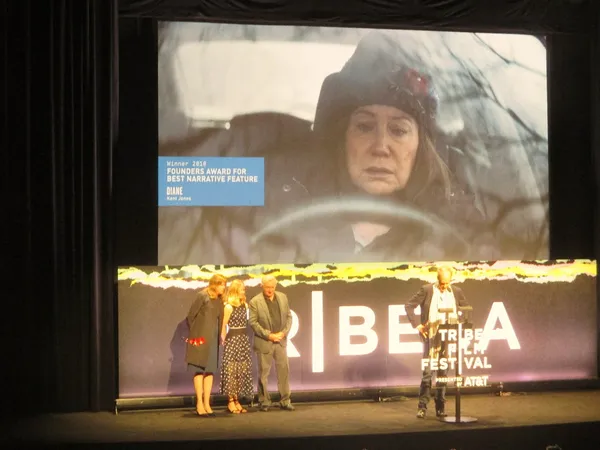 |
| Kent Jones accepts Tribeca Film Festival Founders Award from Jane Rosenthal, Fiona Carter (AT&T), and Robert De Niro Photo: Anne-Katrin Titze |
In the second instalment of my conversation with Diane director/screenwriter Kent Jones, he connects filmmakers Claire Denis, Olivier Assayas, David Fincher, Jean-Pierre Dardenne and Luc Dardenne, a scene from Martin Scorsese's Gangs Of New York between Daniel Day-Lewis and Leonardo DiCaprio, and his Diane team of Carisa Kelly and Debbie De Villa.
Diane, starring Mary Kay Place with a terrific supporting cast including Jake Lacy, Joyce Van Patten, Andrea Martin, Deirdre O'Connell, Estelle Parsons, Barbara Andres, Phyllis Somerville and Charles Weldon, will be having having its International Première in competition at the Locarno International Film Festival on August 3.
 |
| Kent Jones with Gone Girl director David Fincher at the 52nd New York Film Festival Photo: Anne-Katrin Titze |
At this year's Tribeca Film Festival, Diane was the big winner, taking home the Founders Award for Best US Narrative Feature, Best Screenplay and Best Cinematography for Wyatt Garfield.
A stack of laundered clothes folded on a car seat, the flower pattern of a borrowed casserole dish, Agatha Christie books for the dying cousin, onions in the fruit basket, an Italian water pitcher, a brown car in front of a brown house - the compositions are neither pretty, nor stylised, nor do they evoke nostalgia in Kent Jones's slow cooking Diane.
Rather, they seem to say, this is someone's life, different from yours, possibly with some overlaps. This is what they see and touch every day. And think about, because we get glimpses of Diane's to-do-lists and some diary entries. And, most importantly, driving structures everything.
Diane (Mary Kay Place), a widow, is surrounded by a large extended family who all live in the same rural area of Western Massachusetts and get together often in one of their homes. Her son Brian (Jake Lacy) doesn't know how to deal with his life there and struggles with drugs of one sort or another to give him meaning.
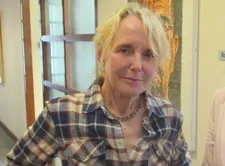 |
| Kent Jones: "Claire Denis such a powerful filmmaker, her sense of time." Photo: Anne-Katrin Titze |
Anne-Katrin Titze: A question I was asking myself after seeing Diane was: how supremely personal is the experience of a movie really? Because it is so clear that I am seeing a very personal story, in this case one I had to find an entryway into.
The other end of the spectrum for me is 20th Century Women. Annette Bening is my grandmother when I was growing up. She looks like her and often acts like her and I felt pangs of recognition throughout.
Kent Jones: Yeah, I related to that movie very strongly.
AKT: In your film, it happened fairly late for me, when Diane is walking in the snowy forest. She looks up and that's when the film opens up and became, for me, universal. And then, next, you have people speaking in tongues! Which is very funny, this juxtaposition of the sublime and the ridiculous and the disorienting.
KJ: You know, one of the most powerful things in cinema is ellipsis. Working with time. It's one of the things that makes Claire Denis such a powerful filmmaker, her sense of time. It's the same thing with the Dardennes. It's the same thing with Olivier [Assayas], you know, David Fincher. You're working with time and it's precious.
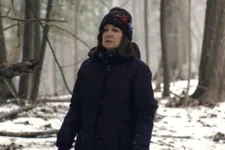 |
| Kent Jones on Mary Kay Place as Diane in the kitchen with her son Brian (Jake Lacy): "The way that Mary Kay did it in the take is just, that's what you want as a director." |
In the case of this [Diane], obviously it's structured in such a way that the time becomes more abstract as it goes along. The driving becomes different than just getting from place to place. I guess that at that point, it's the disorientation.
An example would be in Gangs of New York, after the big confrontation where Daniel Day-Lewis almost kills Leonardo DiCaprio but doesn't. He is taken out of the hall and then the screen goes black and suddenly you're looking at a guy with a lantern. We've never seen him before in the movie and he is going down some kind of a corridor.
You know, that's what I was going for, just to be dropped in the middle of nowhere. What's this face of this woman, speaking in tongues? Which sounds like some kind of fake version of Danish. And being surrounded by all these people, Diane is a little older, and she's looking at her son who is now addicted to something else.
AKT: It's interesting that the walk in the forest, that drew me in the most, comes right before the speaking in tongues.
KJ: I mean, in a way, what I wanted is, the beginning of the movie as you're watching it, feels like one thing; after the end of the movie, it probably should feel like something else.
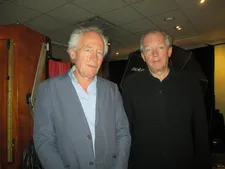 |
| Kent Jones on Jean-Pierre Dardenne and Luc Dardenne's working with time: "You know, one of the most powerful things in cinema is ellipsis." Photo: Anne-Katrin Titze |
AKT: A sentence Brian says and a reaction point to something very universal. He says he has bronchitis. The pause in Diane's reaction speaks volumes. What now? Again? The blatant lie again, where does she go?
KJ: It's when they're back in the kitchen and he says "I just need you to trust me." The way that Mary Kay did it in the take is just, that's what you want as a director. You can see what Diane is thinking: "Okay, I'm not going to do this again, I'm not going to do this again. I'm doing it again. Here we go."
And she's angry at herself. You know, I went down the road with a friend of mine. I remember that kind of feeling. And then when he got clean, he really got clean. And he just did it on his own and almost died. He's in the movie very briefly. He's in a shot.
AKT: The son's laundry, washed by his mother, stacked on the car seat, belongs into the universe of the film. The objects are very specific. For example, she has onions in the fruit basket.
KJ: Yes.
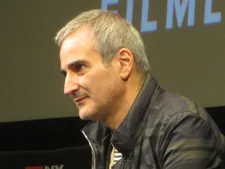 |
| Kent Jones notes that Olivier Assayas is connected to Claire Denis, David Fincher, Jean-Pierre Dardenne, and Luc Dardenne by "working with time and it's precious." Photo: Anne-Katrin Titze |
AKT: The onions say so much, as does the flower pattern on the casserole that is moving back and forth.
KJ: Very important.
AKT: These things make it a clear universe. At the same time, one that I did not recognise. I noticed that I was looking for an object to connect to - which is interesting in itself and does not regularly happen with movies - and there it was. There's an In Aqua Salus pitcher from Italy. Do you know which one I'm talking about? Orange with sea monsters?
KJ: Yes.
AKT: We had the same pitcher when I was growing up. The pots and objects made it real.
KJ: You know, these are the things that make movies. There's also the production design. [Costume designer] Carisa [Kelly] and [production designer] Debbie De Villa knew each other. They were a team. The objects were … For instance, the cross that's hanging in Diane's back wall of her bedroom, the gold cross - I had one in my room when I was a kid. You know, certain objects were very very important to me. The photographs, those were all family photographs.
![Kent Jones on Diane's In Aqua Salus pitcher from Italy: "That was something Debbie [De Villa] found, the production designer."](/images/newsite/In_Aqua_Salus_pitcher_225.webp) |
| Kent Jones on Diane's In Aqua Salus pitcher from Italy: "That was something Debbie [De Villa] found, the production designer." Photo: Anne-Katrin Titze |
AKT: Does the Italian pitcher have a story?
KJ: The Italian pitcher, that was something Debbie found, the production designer.
Read what Kent Jones had to say on the road, costume design, and passports to another universe in Diane.
Kent Jones will present Diane at the Locarno International Film Festival. Public screenings: Friday, August 3 at 2:00pm - Palexpo; Saturday, August 4 at 10:00pm - La Sala; Sunday, August 5 at 11:15am - PalaVideo
The 71st Locarno International Film Festival runs from Wednesday, August 1 through Saturday, August 11.
























